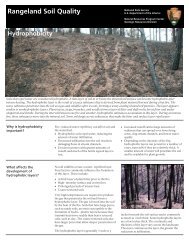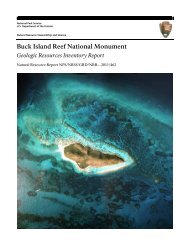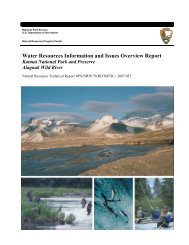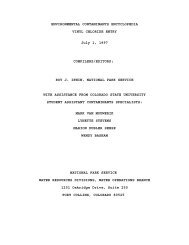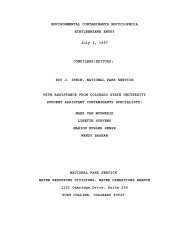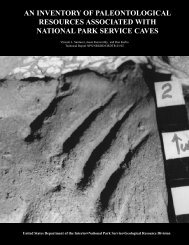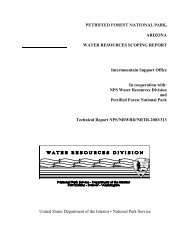toluene - National Park Service
toluene - National Park Service
toluene - National Park Service
Create successful ePaper yourself
Turn your PDF publications into a flip-book with our unique Google optimized e-Paper software.
activity respectively(13). [(1) Tabak HH et al; J Water<br />
Pollut Control Fed 53: 1503-8 (1981) (2) Davis EM et al;<br />
Water Res 15: 1125-7 (1981) (3) Bridie AL et al; Water<br />
Res 13: 627-30 (1979) (4) Kawasaki M; Ecotox Environ<br />
Safety 4: 444-54 (1980) (5) Malaney GW, McKinney RE;<br />
Water Sewage Works 113: 302-9 (1966) (6) Price KS et al;<br />
J Water Pollut Control Fed 46: 63-77 (1974) (7) Matsui S<br />
et al; Prog Water Technol 7: 645-59 (1975) (8) Van der<br />
Linden AC; Dev Biodegrad Hydrocarbons 1: 165-200 (1978)<br />
(9) Button DK et al; Appl Environ Microbiol 42: 708-19<br />
(1981) (10) Lee RF; 1977 Oil Spill Conf Amer Petrol Inst<br />
p 611-6 (1977) (11) Reichardt PB et al; Environ Sci<br />
Technol 15: 75-9 (1981) (12) Wakeham SG et al; Environ<br />
Sci Technol 17: 611-7 (1983) (13) Grbic-Galic D, Vogel<br />
TM; Appl Environ Microbiol 53: 254-60 (1987).<br />
Toluene completely degraded in groundwater in 8 days<br />
including a lag of 3-4 days while microbial populations<br />
became acclimated(1). Other investigators found that only<br />
1-2% of <strong>toluene</strong> degraded in the subsurface environment(2)<br />
and >90% degraded in 4 weeks in soil cores at various<br />
depths both above and below the water table(3,5).<br />
Microbial attack proceeds via immediate hydroxylation of<br />
the benzene ring followed by ring-cleavage or oxidation<br />
of the side chain followed by hydroxylation and ringcleavage(4).<br />
[(1) Kappeler T, Wuhrmann K; Water Res 12:<br />
327-33 (1978) (2) Wilson JT et al; Devel Indust Microbiol<br />
24: 225-33 (1983) (3) McNabb JF et al; 81st Ann Mtg Amer<br />
Soc Microbiology p.213 (1981) (4) Fewson CA; FEMS Symp 12<br />
(Microb Deg Xenobiotics Recalcitrant Cmpds): 141-79<br />
(1981) (5) Wilson JT et al; Ground Water 21: 134-42<br />
(1983).<br />
Environmental degradation: ... Bacterial strains isolated<br />
from soil that closely resemble pseudomonas desmolytica<br />
can utilize <strong>toluene</strong> as their sole carbon source, as can<br />
norcardia cultures, aeruginosa, & p oleovorans. ...<br />
Toluene is biodegraded primarily through side chain<br />
hydroxylation. [Clayton, G. D. and F. E. Clayton (eds.).<br />
Patty's Industrial Hygiene and Toxicology: Volume 2A, 2B,<br />
2C: Toxicology. 3rd ed. New York: John Wiley Sons, 1981-<br />
1982. 3290<br />
Biological oxygen demand 2.15 G oxygen/g <strong>toluene</strong>;<br />
chemical oxygen demand 2.52 G oxygen/g <strong>toluene</strong>. [BRIDIE<br />
AL ET AL; WATER RESEARCH 13: 627 (1979).<br />
Biological oxygen demand: 0% in 5 days; theoretical<br />
oxygen demand: 38% in 8 days [U.S. Coast Guard,<br />
Department of Transportation. CHRIS - Hazardous Chemical<br />
Data. Volume II. Washington, D.C.: U.S. Government<br />
Printing Office, 1984-5.<br />
Abiotic Degradation [609]:





